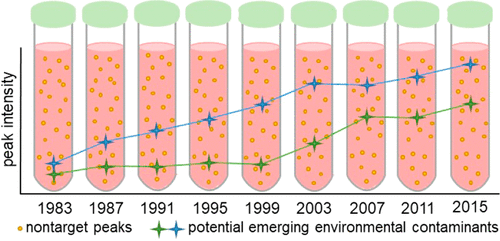当前位置:
X-MOL 学术
›
Environ. Sci. Technol. Lett.
›
论文详情
Our official English website, www.x-mol.net, welcomes your
feedback! (Note: you will need to create a separate account there.)
Nontarget Time Trend Screening in Human Blood
Environmental Science & Technology Letters ( IF 8.9 ) Pub Date : 2018-05-30 , DOI: 10.1021/acs.estlett.8b00196 Merle M. Plassmann 1 , Stellan Fischer 2 , Jonathan P. Benskin 1
Environmental Science & Technology Letters ( IF 8.9 ) Pub Date : 2018-05-30 , DOI: 10.1021/acs.estlett.8b00196 Merle M. Plassmann 1 , Stellan Fischer 2 , Jonathan P. Benskin 1
Affiliation

|
Human biomonitoring (HBM) programs monitor exposure to a limited number of prioritized chemicals resulting in some important substances being overlooked. Nontarget analysis shows promise for capturing novel substances, yet the large quantity of data produced by these methods remains challenging to interrogate. Here, we apply a prioritization strategy for temporal nontarget HBM data, which shortlists features with increasing time trends, possibly representing substances which are bioaccumulating or to which humans are increasingly exposed. Human whole blood sampled in Germany between 1983 and 2015 was extracted using a modified QuEChERS method and analyzed by UHPLC-Oribtrap-mass spectrometry. Following alignment, peak detection, grouping, and gap filling, up to 14,460 features were obtained. This number was reduced to ≤716 using time trend ratios and Spearman’s rank correlation coefficients to identify features which increased over the 32-year time series. Increasing features were investigated further using the KemI market list database (which prioritizes based on human hazard and/or exposure potential) as well as data-dependent product ion scans, followed by MetFrag and mzCloud database searches. Finally, seven prioritized substances, including one pharmaceutical, two pesticides, and four performance chemicals, were confirmed using standards, demonstrating the potential of time trend screening as a prioritization strategy for nontarget HBM data.
中文翻译:

人血中非目标时间趋势筛查
人体生物监测(HBM)计划监测有限数量的优先化学品的暴露,从而导致一些重要物质被忽略。非目标分析显示了捕获新物质的希望,但是通过这些方法产生的大量数据仍然难以质疑。在此,我们对时间非目标HBM数据应用优先级排序策略,该策略会随着时间趋势的增长而将特征入围,这可能代表了具有生物蓄积性或人类日益暴露的物质。使用改良的QuEChERS方法提取了1983年至2015年在德国采样的人类全血,并通过UHPLC-Oribtrap-质谱法进行了分析。经过对准,峰检测,分组和间隙填充后,获得了多达14,460个特征。使用时间趋势比率和Spearman等级相关系数将该数字减少到≤716,以识别在32年时间序列中增加的特征。使用KemI市场列表数据库(基于人的危害和/或暴露潜力确定优先级)以及与数据相关的产物离子扫描,然后进行MetFrag和mzCloud数据库搜索,进一步研究了越来越多的功能。最后,使用标准确定了七种优先物质,包括一种药物,两种农药和四种功能化学品,证明了时间趋势筛选作为非目标HBM数据优先战略的潜力。使用KemI市场列表数据库(基于人的危害和/或暴露潜力确定优先级)以及与数据相关的产物离子扫描,然后进行MetFrag和mzCloud数据库搜索,进一步研究了越来越多的功能。最后,使用标准确定了七种优先物质,包括一种药物,两种农药和四种功能化学品,证明了时间趋势筛选作为非目标HBM数据优先战略的潜力。使用KemI市场列表数据库(基于人的危害和/或暴露潜力确定优先级)以及与数据相关的产物离子扫描,然后进行MetFrag和mzCloud数据库搜索,进一步研究了越来越多的功能。最后,使用标准确定了七种优先物质,包括一种药物,两种农药和四种功能化学品,证明了时间趋势筛选作为非目标HBM数据优先战略的潜力。
更新日期:2018-05-31
中文翻译:

人血中非目标时间趋势筛查
人体生物监测(HBM)计划监测有限数量的优先化学品的暴露,从而导致一些重要物质被忽略。非目标分析显示了捕获新物质的希望,但是通过这些方法产生的大量数据仍然难以质疑。在此,我们对时间非目标HBM数据应用优先级排序策略,该策略会随着时间趋势的增长而将特征入围,这可能代表了具有生物蓄积性或人类日益暴露的物质。使用改良的QuEChERS方法提取了1983年至2015年在德国采样的人类全血,并通过UHPLC-Oribtrap-质谱法进行了分析。经过对准,峰检测,分组和间隙填充后,获得了多达14,460个特征。使用时间趋势比率和Spearman等级相关系数将该数字减少到≤716,以识别在32年时间序列中增加的特征。使用KemI市场列表数据库(基于人的危害和/或暴露潜力确定优先级)以及与数据相关的产物离子扫描,然后进行MetFrag和mzCloud数据库搜索,进一步研究了越来越多的功能。最后,使用标准确定了七种优先物质,包括一种药物,两种农药和四种功能化学品,证明了时间趋势筛选作为非目标HBM数据优先战略的潜力。使用KemI市场列表数据库(基于人的危害和/或暴露潜力确定优先级)以及与数据相关的产物离子扫描,然后进行MetFrag和mzCloud数据库搜索,进一步研究了越来越多的功能。最后,使用标准确定了七种优先物质,包括一种药物,两种农药和四种功能化学品,证明了时间趋势筛选作为非目标HBM数据优先战略的潜力。使用KemI市场列表数据库(基于人的危害和/或暴露潜力确定优先级)以及与数据相关的产物离子扫描,然后进行MetFrag和mzCloud数据库搜索,进一步研究了越来越多的功能。最后,使用标准确定了七种优先物质,包括一种药物,两种农药和四种功能化学品,证明了时间趋势筛选作为非目标HBM数据优先战略的潜力。











































 京公网安备 11010802027423号
京公网安备 11010802027423号